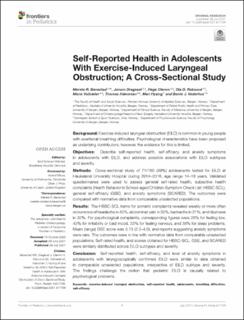| dc.contributor.author | Drageset, Jorunn | |
| dc.contributor.author | Clemm, Hege Synnøve Havstad | |
| dc.contributor.author | Røksund, Ola Drange | |
| dc.contributor.author | Vollsæter, Maria | |
| dc.contributor.author | Halvorsen, Thomas | |
| dc.contributor.author | Hysing, Mari | |
| dc.contributor.author | Vederhus, Bente Johanne | |
| dc.contributor.author | Benestad, Merete Røineland | |
| dc.date.accessioned | 2022-03-10T14:10:10Z | |
| dc.date.available | 2022-03-10T14:10:10Z | |
| dc.date.created | 2021-08-06T09:24:24Z | |
| dc.date.issued | 2021 | |
| dc.identifier.citation | Frontiers in Pediatrics. 2021, 9(2021), Artikkel 617759. | en_US |
| dc.identifier.issn | 2296-2360 | |
| dc.identifier.uri | https://hdl.handle.net/11250/2984347 | |
| dc.description | This is an open-access article distributed under the terms of the Creative Commons Attribution License (CC BY). The use, distribution or reproduction in other forums is permitted, provided the original author(s) and the copyright owner(s) are credited and that the original publication in this journal is cited, in accordance with accepted academic practice. No use, distribution or reproduction is permitted which does not comply with these terms. | en_US |
| dc.description.abstract | Background: Exercise-induced laryngeal obstruction (EILO) is common in young people with exertional breathing difficulties. Psychological characteristics have been proposed as underlying contributors; however, the evidence for this is limited.
Objectives: Describe self-reported health, self-efficacy, and anxiety symptoms in adolescents with EILO, and address possible associations with EILO subtypes and severity.
Methods: Cross-sectional study of 71/180 (39%) adolescents tested for EILO at Haukeland University Hospital during 2014–2016, age range 14–18 years. Validated questionnaires were used to assess general self-rated health, subjective health complaints (Health Behavior in School-aged Children-SymptomCheck List; HBSC-SCL), general self-efficacy (GSE), and anxiety symptoms (SCARED). The outcomes were compared with normative data from comparable unselected populations.
Results: The HBSC-SCL items for somatic complaints revealed weekly or more often occurrence of headache in 42%, abdominal pain in 30%, backache in 31%, and dizziness in 32%. For psychological complaints, corresponding figures were 26% for feeling low, 43% for irritability or bad mood, 33% for feeling nervous, and 38% for sleep problems. Mean (range) GSE score was 3.13 (2.2–4.0), and reports suggesting anxiety symptoms were rare. The outcomes were in line with normative data from comparable unselected populations. Self-rated health, and scores obtained for HBSC-SCL, GSE, and SCARED were similarly distributed across EILO subtypes and severity.
Conclusion: Self-reported health, self-efficacy, and level of anxiety symptoms in adolescents with laryngoscopically confirmed EILO were similar to data obtained in comparable unselected populations, irrespective of EILO subtype and severity. The findings challenge the notion that pediatric EILO is causally related to psychological problems. | en_US |
| dc.language.iso | eng | en_US |
| dc.subject | adolescents | en_US |
| dc.subject | breathing difficulties | en_US |
| dc.subject | exercise-induced laryngeal obstruction | en_US |
| dc.subject | self-efficacy | en_US |
| dc.subject | self-reported health | en_US |
| dc.title | Self-reported health in adolescents with exercise-induced laryngeal obstruction; A cross-sectional study | en_US |
| dc.type | Peer reviewed | en_US |
| dc.type | Journal article | en_US |
| dc.description.version | publishedVersion | en_US |
| dc.rights.holder | © 2021 Benestad, Drageset, Clemm, Røksund, Vollsæter, Halvorsen, Hysing and Vederhus | en_US |
| dc.source.pagenumber | 7 | en_US |
| dc.source.volume | 9 | en_US |
| dc.source.journal | Frontiers in Pediatrics | en_US |
| dc.identifier.doi | 10.3389/fped.2021.617759 | |
| dc.identifier.cristin | 1924303 | |
| dc.description.localcode | Institutt for idrettsmedisinske fag / Department of Sports Medicine | en_US |
| dc.source.articlenumber | 617759 | en_US |
| cristin.ispublished | true | |
| cristin.fulltext | original | |
| cristin.qualitycode | 1 | |
